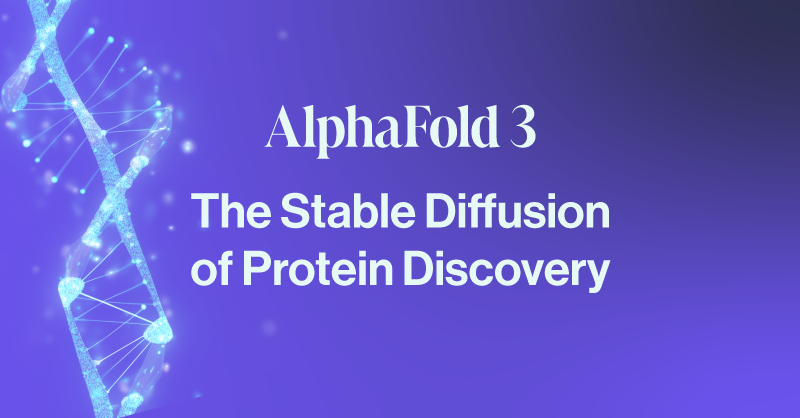Last week, May 5th, there was a huge breakthrough for the molecular biology field or the entire life science and scientific field in general with the newly updated and release of AlphaFold 3, successor to the infinitely popular AlphaFold 2.
AlphaFold 2 is made open source and is used by 95% of research labs performing structural biology to predict the way a protein folds based on its amino acid sequence. It can model protein to protein interactions using extensions for ligands and docking.
With AlphaFold 3, researchers and scientists can now analyze even more than just proteins, but also complexes that include proteins, nucleic acids, the DNA, RNA, small molecules, and ions.
Advancements in AlphaFold 3 vs AlphaFold 2
- Broader Use Case: AlphaFold 3 not only predicts protein to protein interactions but how proteins interact with other biomolecules such as DNA, other molecules,
- Diffusion: AlphaFold 3 uses a diffusion model to generate atomic coordinates for docking and modeling biomolecular interactions without the need for excessive specialization. Implements a cross-distillation to prevent hallucinations.
- Improved Accuracy: AlphaFold 3 significantly enhances prediction accuracy. For protein interactions with other molecule types, the accuracy has improved by at least 50% over existing methods. For certain critical types of molecular interactions, the accuracy has even doubled.
- Enhanced Evoformer: the pivotal technology that gave AlphaFold 2 life was the Evoformer. AlphaFold 3 improves upon it, called the Pairformer, which leverages diffusion to generate results.
Limitations in AlphaFold 3 vs AlphaFold 2
- Slight Inaccuracies: While AlphaFold 3 is more accurate all around, it can struggle with protein-RNA
- Hallucinations: The use of a diffusion model leads to some hallucinations, similar to how text to image AI struggles with hands and text. AlphaFold 3 uses a cross-distillation algorithm to mitigate the risk.
- Restricted Access: The biggest one is the non-publicly available code. AlphaFold 2 is open source, and you can download it on your machine from their GitHub, but AlphaFold 3, currently, is only accessible through their AlphaFold Server.
Thoughts on AlphaFold 3
AlphaFold 1 back in 2018 and AlphaFold 2 in 2020 have truly revolutionized structural biology. While these innovations and research feel like they haven’t trickled down to the public via medicine to deadly pathologies and cures for cancer, almost every biomolecular lab is using AlphaFold in their work.
AlphaFold 3’s enhanced capability to accurately predict how drugs and therapeutic molecules interact with proteins opens up new discoveries within drug design. Understanding complex interactions in the human body is vital for designing new drugs that can effectively target specific proteins or molecules.
It is also good to hear from Isomorphic Lab’s Chief AI Scientist Max Jaderberg regarding the closed source nature of AlphaFold 3 and its eventuality of being released in the future. How they do so, we don’t know.
Really cool to see the huge engagement surrounding AlphaFold 3 and the structures scientists are posting. We’re working to release the AF3 model (incl. weights) in the next 6 months for academic use, so it won’t depend on our research infra. Also the AFServer job limit is now doubling to 20 per day.
— Max Jaderberg (@maxjaderberg) May 13, 2024
If you have any questions regarding workstations and servers for running molecular dynamics simulation, structural biology, or AlphaFold, contact us today!


